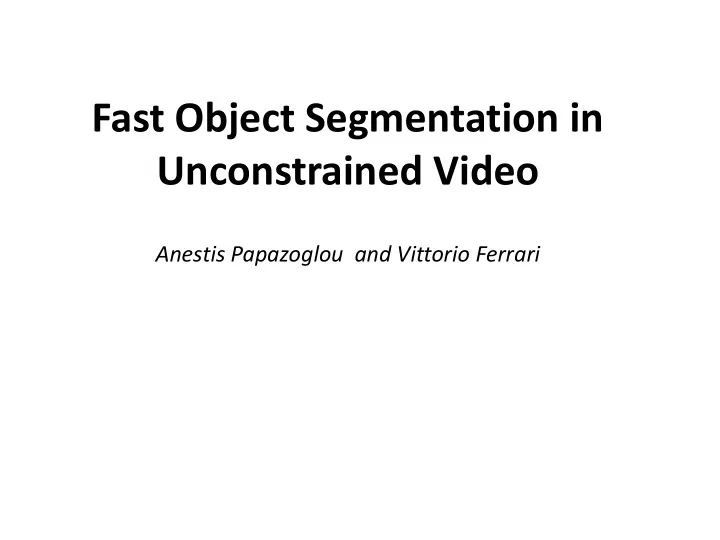

Fast Object Segmentation in Unconstrained Video Anestis Papazoglou and Vittorio Ferrari
Outline Ø Introduction Ø Related Work Ø Method Ø Results Ø References
Introduction Ø Video object segmentation is the task of separating foreground objects from the background in a video Ø Important for a wide range of applications, including providing spatial support for learning object class models, video summarization, and action recognition
Introduction Ø There are two main model for segmentation: • Require user annotation: for example, user should annotate the object position • Fully automatic: the only input is the input video
Introduction Ø This paper proposes a technique for fully automatic video object segmentation in unconstrained settings Ø It makes minimal assumptions about the video:the only requirement is for the object to move differently from its surrounding background in a good fraction of the video
Related Work Object Segmentation by Long Term Analysis of Point Trajectories (T. Ø Brox, J. Malik), ECCV 2010. they describe a motion clustering method ●
Related Work Object Segmentation by Long Term Analysis of Point Trajectories (T. Ø Brox, J. Malik), ECCV 2010. – temporally consistent clusters over many frames can be obtained best by a nalyzing long term point trajectories rather than two-frame motion fields.
Related Work Key-Segments for Video Object Segmentation (Y.J. Lee, J. Kim, K. Ø Grauman), ICCV 2011.
Method Ø The method aims to segment objects that move differently than their surroundings.
Method Ø The method consists of two steps: I. Initial foreground estimation III. Foreground-background labelling refinement
Method I. Initial foreground estimation • The goal of the first stage is to rapidly produce an initial estimate of which pixels might be inside the object based purely on motion. • The motion boundaries detected by optical flow
Initial foreground estimation i. Optical flow estimation
Initial foreground estimation ii. Motion Boundaries m = 1 − exp (−λ∥∇ ⃗ f p ∥) b p
Initial foreground estimation ii. Motion Boundaries 2 )) θ = 1 − exp (−λ θ max q ∈ N (δθ p , q b p
Initial foreground estimation ii. Motion Boundaries b p = { m m > T b p if b p m .b p θ m ≤ T b p if b p
Initial foreground estimation iii. Inside-outside maps
Method II. Foreground-background labelling refinement ➢ They formulate video segmentation as a pixel labelling problem with two labels (foreground and background)
Method II. Foreground-background labelling refinement t ➢ Appearance Model ( ) A • The appearance model consists of two GMM over RGB colour values,one for the foreground and one for the background. • They are estimated automatically based on the inside- t M outside maps t ' s i • Weight of each superpixel in frame t' A. ( t − t ' ) 2 ) . r i t ' • foreground: exp (−λ A. ( t − t ' ) 2 ) . ( 1 − r i t ' ) exp (−λ background:
Method II. Foreground-background labelling refinement t ➢ Location Model ( ) L • inside-outside maps can provide a valuable location prior to anchor the segmentation to image areas likely to contain the object, as they move differently from the surrounding region
Method II. Foreground-background labelling refinement t • Location Model ( ) L
Method II. Foreground-background labelling refinement ➢ Smoothness Terms ● Spatial smoothness potential ● Temporal smoothness potential
Method II. Foreground-background labelling refinement ➢ Smoothness Terms
Results 1) SegTrack
Results 1) SegTrack
Results 2) Youtube Objects
Results 2) Youtube Objects
Thanks
Recommend
More recommend